Spring is a time when the natural world comes alive with vibrant colors, and one of the most breathtaking sights is the bloom of spring yellow wild flowers. From April through May, these beautiful blooms transform meadows across the United States into a sea of yellow.
Imagine walking through a field on a sunny spring day, surrounded by a carpet of vibrant yellow wildflowers. The air is filled with the sweet scent of blooming flowers, and the gentle breeze carries the soft sound of buzzing bees. The sight is simply magical, as if nature itself has painted the landscape with strokes of sunshine.
The vibrant petals of these spring yellow wild flowers seem to dance in the sunlight as they sway with the rhythm of nature. Their vivid colors bring a sense of joy and happiness, filling your heart with warmth and awe.
As you walk further into the meadow, you notice the different varieties of yellow wildflowers that are in bloom. Some have delicate petals that resemble tiny sun rays, while others stand tall and proud, like golden beacons in a sea of green.
These seasonal flowers not only add beauty to the landscape, but they also serve an essential purpose in the ecosystem. They provide nectar and pollen for bees, butterflies, and other pollinators, ensuring the continuation of life and the growth of future generations.
So, take a moment this spring to immerse yourself in the natural spring beauty of these vibrant spring blooms. Explore meadows, fields, and woods, and let the sight of spring yellow wild flowers fill your senses with wonder and appreciation for the wonders of nature.
Key Takeaways:
- Spring yellow wild flowers bloom from April through May, transforming meadows into a sea of yellow.
- These vibrant blooms add beauty to the landscape and provide food for bees and other pollinators.
- Take the time to explore meadows, fields, and woods to fully appreciate the natural spring beauty of these flowers.
- Walking among a carpet of vibrant yellow wildflowers can bring a sense of joy and wonder.
- Spring yellow wildflowers are a testament to the magic and beauty of the changing seasons.
Spring Yellow Wildflowers in April
In April, as the first explosion of color after winter, you can expect to see several common yellow wildflowers. Some of these include Winter Cress, Butterweed, Golden Ragwort, and Violets. These flowers can be found in fields, wet areas, and woods, adding vibrant splashes of yellow to the landscape.
As the days grow longer and warmer, nature awakens with a burst of life. The sight of blooming wildflowers brings joy and wonder, especially when they paint the landscape in shades of yellow. In April, the spring season is in full swing, and yellow flora begins to make its grand entrance.
“The flowers are nature’s jewels, embellishing the world with their vibrant colors. In April, the yellow wildflowers take the spotlight, captivating our hearts and souls.” – Me
One of the iconic spring yellow wildflowers is the Winter Cress. Its bright yellow petals elegantly unfold, creating a beautiful contrast against the green backdrop. Butterweed is another stunning wildflower that blooms in April, with its clusters of small yellow flowers that seem to dance in the breeze. Golden Ragwort adds a touch of radiance with its golden-yellow blossoms that gracefully sway in wet areas. Violets, although commonly associated with purple, also come in shades of yellow and provide a delicate beauty to wooded areas and fields.
These blooming wildflowers not only enhance the visual appeal of the surroundings but also attract pollinators like bees and butterflies, contributing immensely to the ecological balance. Their vibrant hues and delicate petals serve as nature’s invitations for these pollinators to work their magic.
Yellow Wildflowers in April:
- Winter Cress
- Butterweed
- Golden Ragwort
- Violets
So, take a stroll through meadows, venture into wet areas, or immerse yourself in the tranquility of the woods and witness the enchanting beauty of these yellow wildflowers in April. Their vibrant display is nature’s way of welcoming spring and reminding us of the beauty and resilience of the natural world.
April’s Spring Ephemerals
In April, the arrival of spring brings a breathtaking display of colorful wildflowers, transforming woodland areas into vibrant meadows. Known as Spring Ephemerals, these delicate blooms take advantage of the fleeting sunlight before the leaves of the trees block out much of the sun. Their short-lived beauty adds a touch of magic to the natural landscape.
Some of the enchanting spring ephemerals that grace the woodlands in April include:
- Spring Beauties – These dainty flowers showcase delicate pink and white petals with vibrant yellow centers. They carpet the forest floor and create a whimsical atmosphere.
- Virginia Bluebells – With their lovely clusters of bell-shaped, sky-blue flowers, Virginia Bluebells bring a burst of color to shaded areas.
- Bloodroot – Named for its deep reddish sap, Bloodroot features exquisite white flowers and distinctively lobed leaves. It is a true treasure to discover.
- Dutchman’s Breeches – Resembling miniature pantaloons, these delicate white flowers dangle gracefully, adding a touch of ethereal beauty.
- Rue Anemone – This charming wildflower showcases delicate clusters of white or pale pink flowers, accompanied by deeply divided leaves.
- Blue Phlox – A carpet of fragrant blue, lavender, or white flowers, Blue Phlox create a dreamy, peaceful ambiance in woodlands.
These wildflowers paint a colorful tapestry in woodland areas, inviting visitors to explore their wonders. Witnessing the burst of life and vibrant hues of the April Spring Ephemerals is truly a spectacle to behold.

May’s Yellow Blooms
In May, nature continues to dazzle with the vibrant hues of yellow blooms. This month, you can witness the breathtaking emergence of several spring yellow wild flowers, adding a burst of sunshine to the landscape. Let’s explore some of the floral beauties that grace us with their presence during this time.
Fleabane
One of the captivating yellow blooms you can spot in May is the Fleabane. With its daisy-like appearance and bright yellow petals, this wildflower is a delightful sight in fields and along roads. Its name, derived from the belief that it repels fleas, adds to its charm.
Ox eye Daisy
The Ox eye Daisy is another striking yellow wildflower that blooms in May. Its large, showy flowers with yellow petals and a prominent golden center are a true testament to the beauty of nature. You can find these daisies adding a touch of elegance to meadows and grassy areas.
Hemlock
Amidst the May landscape, you might encounter the delicate yellow flowers of the Hemlock plant. Though known for its poisonous nature, the beauty of its blossoms cannot be denied. These cluster-like flowers emerge from the plant, creating an enchanting display in wet areas and meadows.
Buttercups
The sight of Buttercups in May is a sure sign that spring is in full bloom. These cheerful yellow flowers with glossy petals are synonymous with sunny days and rejuvenation. Look for these vibrant blooms in wet meadows and grasslands, where they add a touch of natural splendor.
Yellow Goat’s Beard and Hawkweed
In May, you might come across two yellow wildflowers that stand out with their distinctive features. Yellow Goat’s Beard, also known as False Dandelion, showcases bright yellow flower heads composed of numerous ray-like petals. Hawkweed, on the other hand, boasts clusters of daisy-like yellow flowers that grace fields and roadsides.
The image above captures the essence of May’s yellow blooms, showcasing the natural spring beauty and vibrant spring blooms that adorn our surroundings during this time. As you venture out to witness nature’s colorful spectacle, keep an eye out for these mesmerizing yellow wildflowers that add an extra dose of enchantment to the season.
May Flowers in the Woods
While the woods may have fewer flowers in May due to the denser undergrowth, you can still spot some beautiful yellow blooms. Look out for Wild Geranium, Waterleaf, and Sweet Cicely, which can be found in wooded areas, adding a touch of elegance to the natural surroundings.
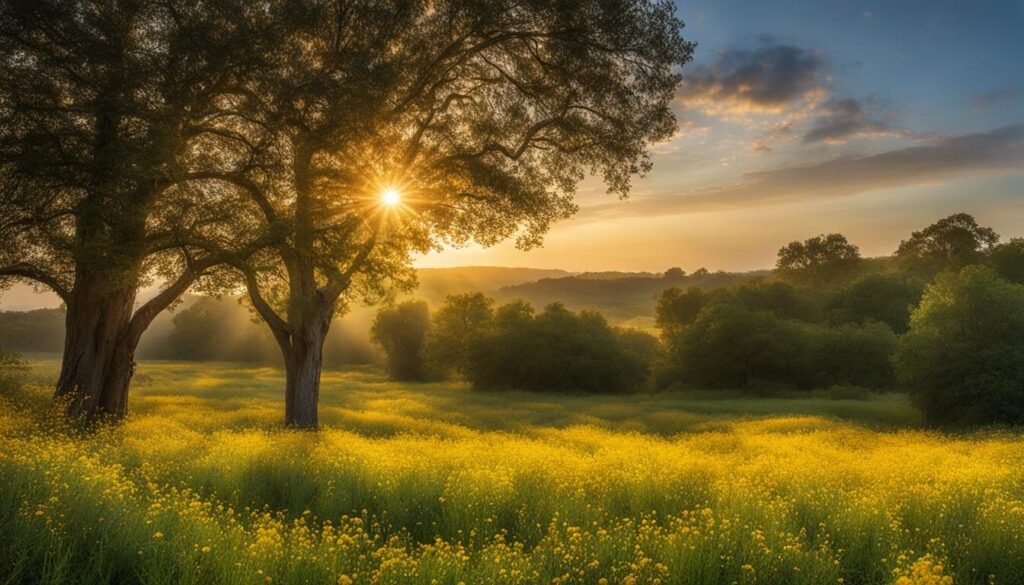
Exploring the Enchanting Woodlands
The lush greenery and serene atmosphere of the woods provide the perfect backdrop for capturing the beauty of spring yellow wildflowers. If you’re passionate about wildflower photography, venturing into the woods can offer unique and captivating opportunities to capture stunning close-ups and breathtaking landscapes.
“The woods are a sanctuary of tranquility and wonder, where the spring yellow wildflowers add a splash of color to create captivating compositions. Every step reveals a hidden gem, a perfect subject for my lens.” – Amy Thompson, professional photographer.
Exploring a Spring Flower Field
If you prefer a more open and expansive setting, a spring flower field is an ideal location to immerse yourself in a sea of yellow blooms. The vivid hues and gentle swaying of the flowers in the breeze create a sense of harmony and natural beauty.
- Capture the vibrant colors and delicate details of spring yellow wildflowers up close
- Experiment with different angles and lighting to create stunning compositions
- Immerse yourself in the tranquility of the blooming meadows and embrace the serenity of nature
Whether you’re exploring the enchanting woods or the expansive fields, the beauty of spring yellow wildflowers awaits. Don’t miss the opportunity to witness and capture the wonders of nature in all its glory.
Late Summer Yellow Delights
As late summer arrives, a new burst of color emerges with an array of vibrant yellow wildflowers. These blooming wildflowers add a touch of sunny cheer to various habitats, including dry areas, open fields, and disturbed earth. Let’s take a closer look at some of these late summer yellow delights:
Desert Dandelion
One of the standout wildflowers of late summer is the Desert Dandelion. With its striking yellow blooms, it thrives in arid regions and brings a burst of color to the desert landscape. The Desert Dandelion’s resilience in harsh conditions is truly remarkable.
Greenstem Paperflower
The Greenstem Paperflower is another remarkable yellow wildflower you can spot in late summer. This delicate plant with its small yellow flowers brightens up disturbed and rocky areas, adding a touch of beauty to otherwise barren spaces.
Yellow Salsify
The Yellow Salsify is a tall and elegant wildflower that graces open fields and meadows during late summer. Its bright yellow daisy-like flowers sway in the breeze, creating a picturesque scene. Be sure to keep an eye out for this stunning bloom.
Golden Crownbeard
One cannot ignore the Golden Crownbeard, with its striking golden-yellow flowers that resemble small crowns. This wildflower stands tall in fields and prairies, attracting bees and butterflies with its nectar-rich blossoms.
These late summer yellow delights contribute to the vibrant spring blooms, extending the beauty of the season into the warmer months. Their presence brings joy and awe to nature enthusiasts, hikers, and photographers alike.
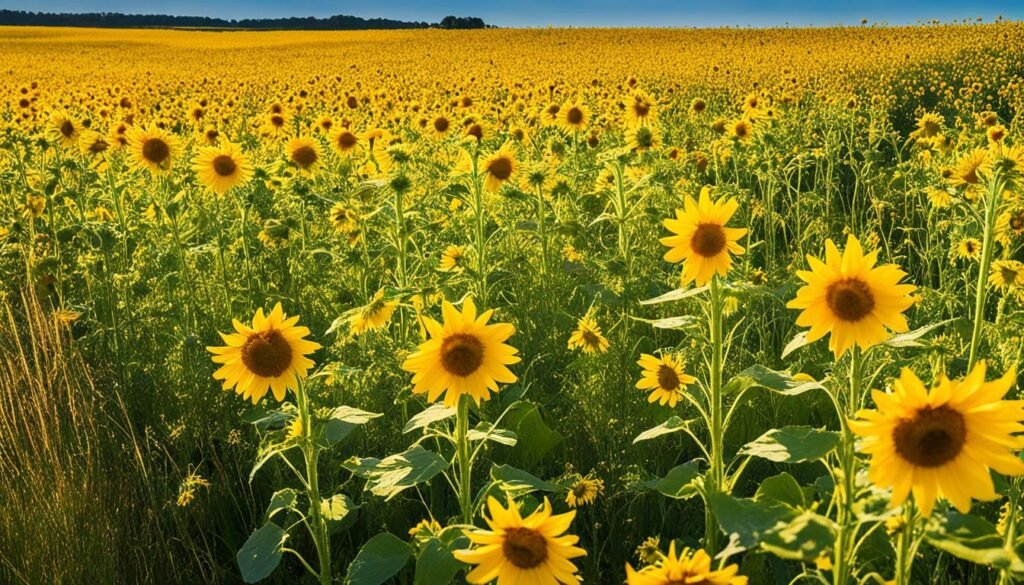
| Wildflower | Habitat |
|---|---|
| Desert Dandelion | Arid regions, desert landscapes |
| Greenstem Paperflower | Disturbed areas, rocky terrain |
| Yellow Salsify | Open fields, meadows |
| Golden Crownbeard | Fields, prairies |
Late Summer Sunflowers
As late summer arrives, the fields and open spaces come alive with the vibrant hues of sunflowers. These seasonal flowers, with their bright and cheerful yellow blooms, create a captivating display of vibrant spring blooms. Notable species of sunflowers that dominate the late summer landscape include Max’s Sunflower, Upright Prairie Coneflower, Threadleaf Groundsel, and Plains Zinnia. These stunning sunflowers can reach impressive heights and add a burst of color to the natural beauty of the surrounding areas.
Max’s Sunflower (Helianthus maximiliani) is a tall and majestic sunflower species that can grow up to 10 feet in height. With its large, daisy-like flowers and prominent yellow petals, Max’s Sunflower is a sight to behold in fields and prairies.
Upright Prairie Coneflower (Ratibida columnifera) is another striking sunflower species that graces the late summer landscape. Its distinctive cone-shaped center, surrounded by bright yellow petals, adds an interesting architectural element to any wildflower meadow.
Threadleaf Groundsel (Senecio flaccidus) is a delicate yet resilient sunflower that blooms in late summer. Its fern-like leaves and small yellow flowers create a delicate and textural addition to the landscape, making it a favorite among wildflower photographers.
Plains Zinnia (Zinnia grandiflora) is a compact and bushy sunflower species that thrives in open grasslands and arid regions. Its bright yellow flowers, resembling delicate daisies, bring a splash of color to the late summer scenery.
Notable Late Summer Sunflowers
- Max’s Sunflower (Helianthus maximiliani)
- Upright Prairie Coneflower (Ratibida columnifera)
- Threadleaf Groundsel (Senecio flaccidus)
- Plains Zinnia (Zinnia grandiflora)
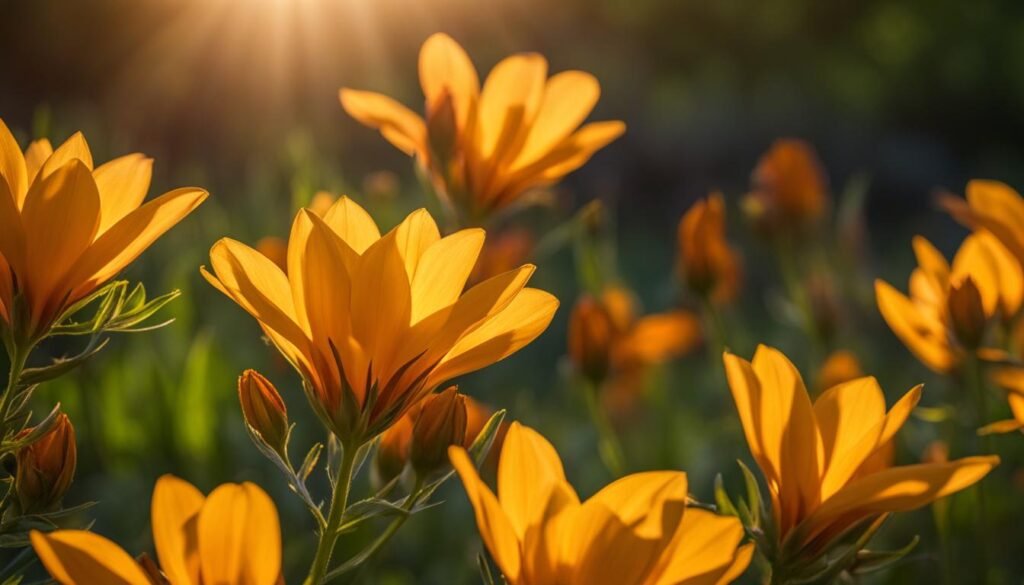
Fall Yellow Beauties
As the seasons transition into fall, I am always delighted to witness the breathtaking beauty of autumn wildflowers. These vibrant yellow blooms provide a touch of warmth and brightness to the changing landscape. Some of my favorite fall yellow beauties include:
- Bittersweet
- Hamamelis virginiana (Witch Hazel)
- Chrysopsis mariana
- Bidens cernua
Each of these autumn wildflowers brings its own unique charm and adds a dash of natural spring beauty to the surroundings. Whether you come across a cluster of Bittersweet berries, catch a whiff of the calming scent of Witch Hazel, or admire the delicate blooms of Chrysopsis mariana and Bidens cernua, these yellow beauties never fail to captivate.
Take a moment to appreciate nature’s artistry as you stumble upon these fall yellow wildflowers during your outdoor exploration.
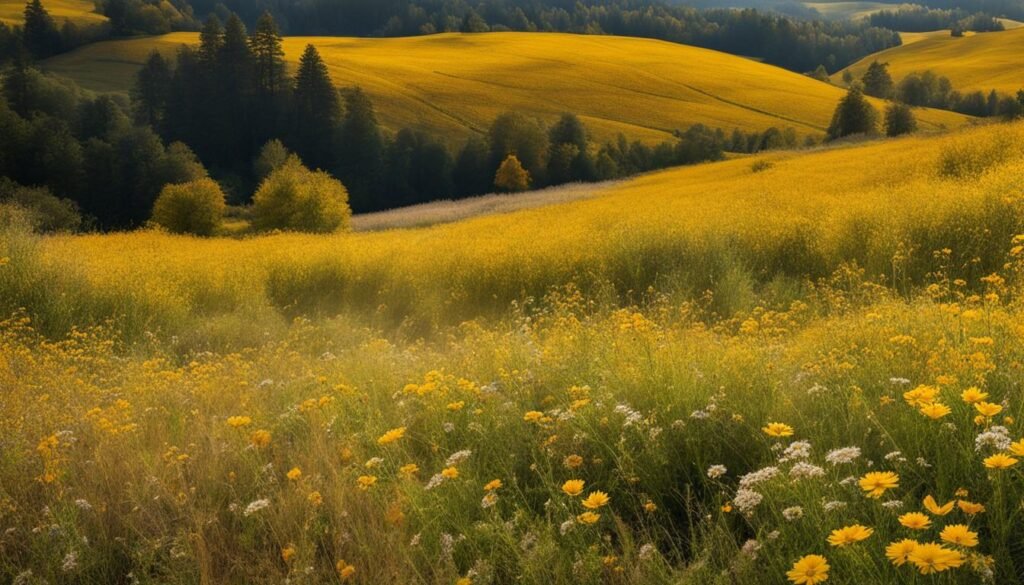
A Closer Look: Hamamelis virginiana (Witch Hazel)
One of the standout fall yellow beauties is the Hamamelis virginiana, commonly known as Witch Hazel. This flowering shrub boasts clusters of bright yellow flowers that bloom late in the season, typically in October or November. The unique feature of Witch Hazel is its ability to bloom during the fall, even after the leaves have started to change color.
Witnessing the beautiful contrast of golden yellow flowers against the backdrop of vibrant fall foliage is truly a sight to behold.
Witch Hazel can be found in a variety of habitats, including woodlands, stream banks, and wetlands. Its distinctive fragrance and remarkable ability to thrive in the cooler months make it a treasured find for nature enthusiasts and photographers alike.
Chrysopsis mariana: A Golden Delight
Chrysopsis mariana, commonly known as Maryland golden aster, is another delightful fall yellow wildflower. This perennial plant showcases stunning golden yellow blooms that light up the landscape. It typically blooms from late summer through fall, adding a touch of brilliance to meadows, prairies, and open areas.
With its daisy-like appearance and bright hue, Chrysopsis mariana makes a stunning addition to any bouquet or floral arrangement.
Whether you stumble upon Chrysopsis mariana in the wild or choose to cultivate it in your own garden, the golden glow of this versatile wildflower is sure to bring joy and beauty.
Notable Yellow Wildflowers
When it comes to vibrant spring blooms, there are several yellow wildflowers that stand out for their unique characteristics. These stunning flowers add a pop of color and beauty to the natural world. Let’s explore some notable yellow wildflowers:
Skunkbush
The Skunkbush (Rhus trilobata) is a deciduous shrub that produces clusters of yellow flowers in the spring. This wildflower is known for its strong fragrance, reminiscent of skunk, which helps to attract pollinators. It is a hardy plant that can be found in various habitats such as woodlands, prairies, and mountain slopes.
False Hairy Golden Aster
The False Hairy Golden Aster (Heterotheca villosa) is a perennial wildflower that blooms with bright yellow flowers from late spring to early fall. It thrives in open areas, such as grasslands and meadows, and is often found in sandy soils. The False Hairy Golden Aster is a favorite among pollinators, attracting bees, butterflies, and other insects.
St. Johnswort
St. Johnswort (Hypericum perforatum) is a perennial herb with yellow flowers that bloom in late spring and early summer. It is commonly found in open fields, pastures, and along roadsides. St. Johnswort is well-known for its medicinal properties and has been used traditionally for its antidepressant and calming effects.
Cup Plant
The Cup Plant (Silphium perfoliatum) is a tall, native wildflower that produces striking yellow flowers in the summer months. It gets its name from the unique cup-shaped leaves that hold water, providing a convenient source of hydration for birds and insects. Cup Plants can be found in moist prairies, along stream banks, and in wetland areas.
Each of these yellow wildflowers adds its own charm and beauty to the natural world, showcasing the vibrant spring blooms that are a signature of the season.
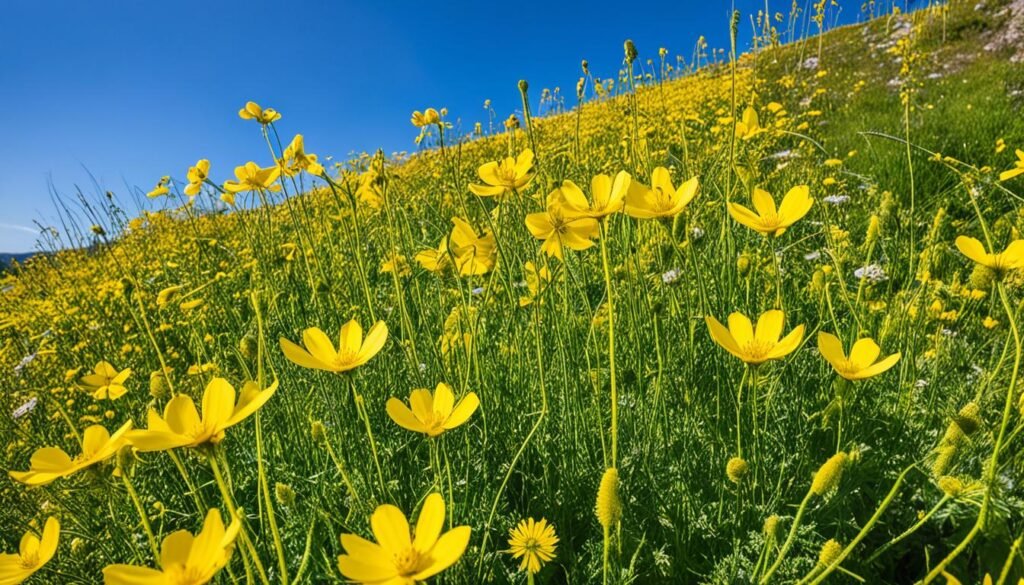
| Yellow Wildflower | Scientific Name | Habitat |
|---|---|---|
| Skunkbush | Rhus trilobata | Woodlands, prairies, mountain slopes |
| False Hairy Golden Aster | Heterotheca villosa | Grasslands, meadows, sandy soils |
| St. Johnswort | Hypericum perforatum | Open fields, pastures, roadsides |
| Cup Plant | Silphium perfoliatum | Moist prairies, stream banks, wetland areas |
Native Yellow Orchids
In late summer, you may be lucky enough to come across native yellow orchids. These delicate blooms are a true treasure to discover in the wild. Some of the native yellow orchids you may encounter include:
- Spotted Coral-root orchid
- Orange Jewelweed
- Canada Lily
- Fringed Orchid
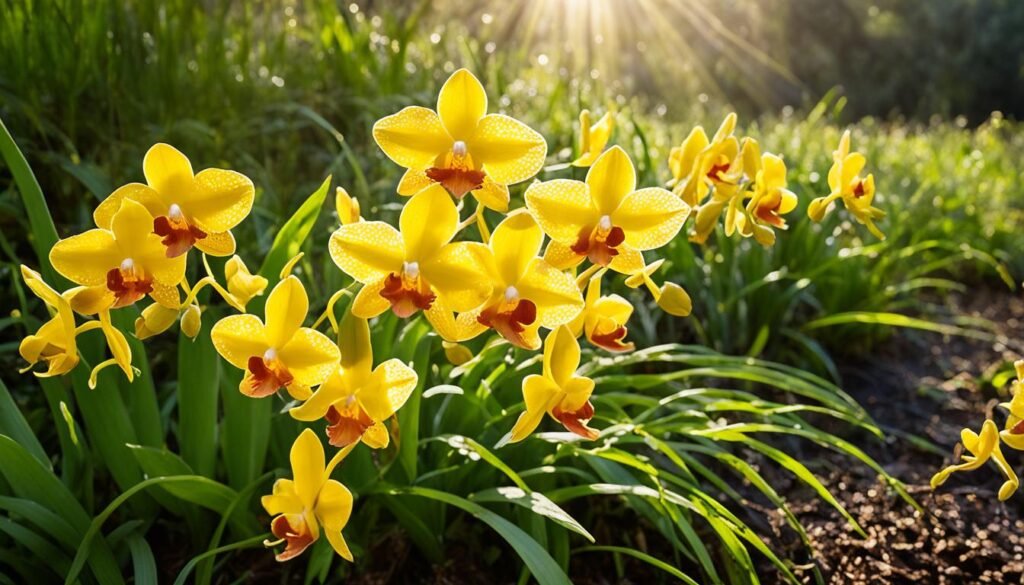
These native yellow orchids add a touch of elegance to any natural setting. With their vibrant yellow blooms, they stand out among the green foliage and create a stunning visual display. Whether you stumble upon them during a hike or actively search for them in a wildflower meadow, these orchids will surely captivate your attention.
Late Summer Evening Primroses
In the late summer months, nature gifts us with the enchanting beauty of evening primroses and sundrops. These stunning yellow flowers, including Oenothera fruticosa, captivate our senses with their large yellow petals and showy blooms.
Evening primroses and sundrops are known for their ability to thrive in a variety of habitats, including open woods and fields. They bring a touch of vibrancy and joy to these natural landscapes, with their bright yellow hues illuminating the surroundings.
If you happen to venture into open woods or fields during late summer, keep an eye out for these marvelous blooms. Their delicate yet striking presence is sure to leave a lasting impression.
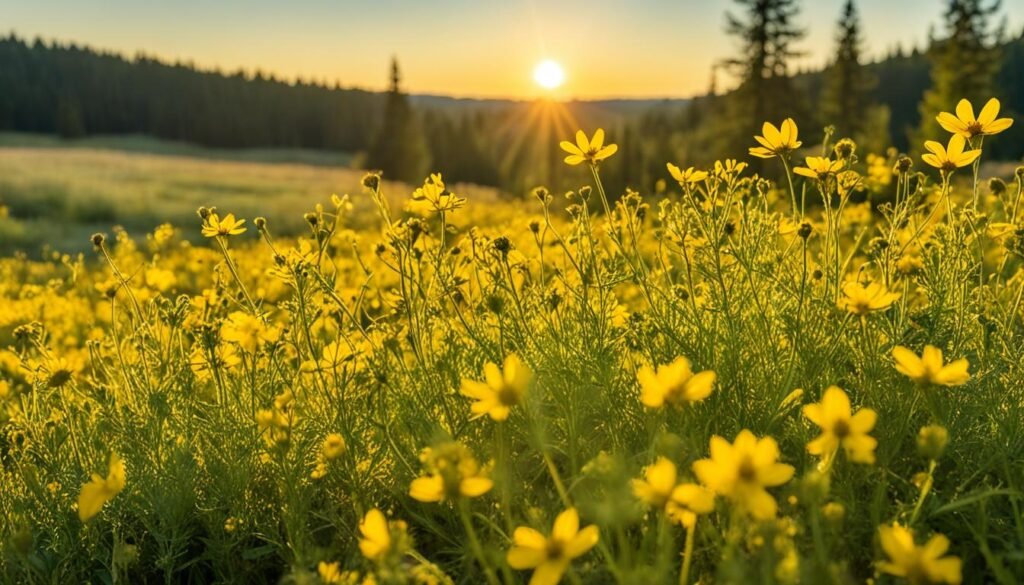
Experience the breathtaking sight of late summer evening primroses and let their radiant beauty inspire you. These seasonal flowers add a unique charm to the blooming wildflowers of spring and summer.
Conclusion
Spring yellow wild flowers bring a burst of color and beauty to the natural landscape during the spring and summer months. From April through August, you can enjoy the vibrant blooms of various yellow wildflowers, adding a touch of sunshine to the world around you. Whether I’m hiking through meadows, exploring the woods, or simply enjoying a walk in nature, I take the time to appreciate the natural spring beauty of these stunning blooms.
These vibrant spring blooms not only delight the eye but also contribute to the ecological balance of the environment. The yellow flora attracts pollinators such as bees, butterflies, and hummingbirds, playing a crucial role in the cycle of life. It’s a true spectacle to witness as these wildflowers come to life and paint the landscape with their cheerful hues.
Next spring, don’t miss the opportunity to immerse yourself in the breathtaking sight of spring yellow wild flowers. Whether you’re a nature lover, an amateur photographer, or simply someone seeking solace in the beauty of the natural world, the vibrant splashes of yellow brought by these wildflowers will captivate and inspire you. Take a moment to appreciate the delicate petals, the subtle fragrances, and the natural spring beauty that surrounds us all.
